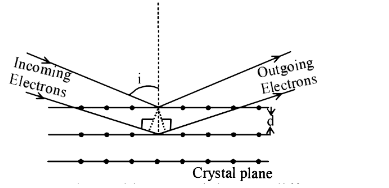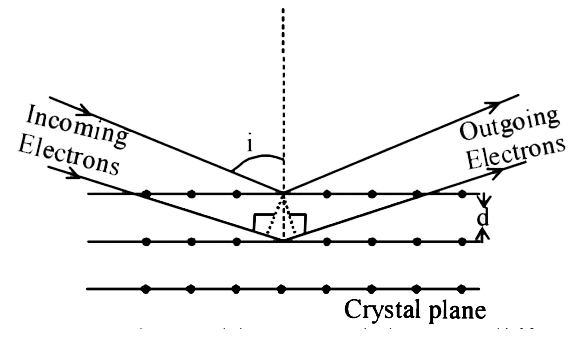Direction:Answer the MCQ no.15 to 17 on the basis of the folowing paragraph:Wave property of electron implies that they will show diffraction effected . Davisson and Germer demonstrated this by diffracting electron from crystals . The law governing the diffraction from a crystals is obtained by requiring that electron waves reflected from the planes of atoms in a crystal interfere constructiely as shown in figure
 .
.
Electrons accelerated by potential V are diffracted from a crystal.Given that h=6.62×10−34Js,e=1.6×10−19C and me=9.1×10−31kg..If d=1∘A and i=30∘,V should be aboutSolution in Punjabi
50 V
500 V
1,000 V
2,000 V
Step by step video & image solution for Direction:Answer the MCQ no.15 to 17 on the basis of the folowing paragraph:Wave property of electron implies that they will show diffraction effected . Davisson and Germer demonstrated this by diffracting electron from crystals . The law governing the diffraction from a crystals is obtained by requiring that electron waves reflected from the planes of atoms in a crystal interfere constructiely as shown in figure .Electrons accelerated by potential V are diffracted from a crystal.Given that h=6.62 xx 10^(-34) J s , e= 1.6 xx 10^(-19) C and m_e = 9.1 xx 10^(-31) kg..If d= 1 overset @A and i= 30^@,V should be about by Physics experts to help you in doubts & scoring excellent marks in Class 12 exams.
Updated on:21/07/2023Topper's Solved these Questions
Similar Questions
The photon of frequency v has a momntum associated with it .If c is the velocity of light,then momentum is
View SolutionTo get five images of a single object, one should have two plane mirrors at an angle of :
View SolutionProve that electromagnetic waves are transverse in nature.
View SolutionWave property of electron implies that they will show diffraction effected . Davisson and Germer demonstrated this by diffracting electron from crystals . The law governing the diffraction from a crystals is obtained by requiring that electron waves reflected from the planes of atoms in a crystal inter fere constructiely Electron accelerated by potential V are diffracted from a crystal if d = 1 Å and i = 30^(@), V should be about (h = 6.6 xx 10^(-34) Js, m_(e) = 9.1 xx 10^(-31) kg , e = 1.6 xx 10^(-19)C)
View SolutionWave property of electron implies that they will show diffraction effected . Davisson and Germer demonstrated this by diffracting electron from crystals . The law governing the diffraction from a crystals is obtained by requiring that electron waves reflected from the planes of atoms in a crystal inter fere constructiely

If a strong diffraction peak is observed when electrons are incident at an angle i from the normal to the crystal planes with distance d between them (see fig) de Brogle wavelength λdB of electrons can be calculated by the relationship (n is an intenger)
View SolutionWave property of electrons implies that they will show diffraction effects. Davission and Germer demonstrated this by diffracting electrons from crystals. The law governing the diffraction from a crystal is obtained by requiring that electron waves reflected from the planes of atoms in a crystal interfere constructively (see figure) In an experiment, electrons are made to pass through a narrow slit of width 'd' comparable to either de-Broglie wavelength. They are detected on a screen at a distance 'D' from the slit The following graphs that can be expected to represent the number of electrons 'N' detected as a function of the detector position 'y' ( y=0 corresponds to the middle of the slit) is
View SolutionWave property of electrons implies that they will show diffraction effects. Davission and Germer demonstrated this by diffracting electrons from crystals. The law governing the diffraction from a crystal is obtained by requiring that electron waves reflected from the planes of atoms in a crystal interfere constructively (see figure) The surface of a metal is illuminated with the light of 400 nm . The kinetic energy of the ejected photoelectrons was found to be 1.68 eV . The work function of the metal is : ( hc = 1240 eV-nm )
View SolutionIn Davisson and Germer experiment, a crystal which diffracts a beam of electrons is of
View SolutionDirection : Question Numbers. 150 and 151 are based on the following paragraph.
Wave property of electrons implies that they will show diffraction effects. Davisson and Germer demonstrated this by diffracting electrons from crystals. The law governing the diffraction from a crystal is obtained by requiring that electron waves reflected from the planes of atoms in a crystal interfere constructively (See figure).

Electrons accelerate by potential V are diffracted from a crystal. If d=1Å and i=30∘, V should be about (h=6.6×10−34Js,me=9.1×10−31kg,e=1.6×10−19C)
View SolutionDirection : Question Numbers. 150 and 151 are based on the following paragraph. Wave property of electrons implies that they will show diffraction effects. Davisson and Germer demonstrated this by diffracting electrons from crystals. The law governing the diffraction from a crystal is obtained by requiring that electron waves reflected from the planes of atoms in a crystal interfere constructively (See figure). If a strong diffraction peak is observed when electrons are incident at an angle i from the normal to the crystal planes with distance d between them (see tigure), de-Broglie wavelength lamda_(dB) of electrons can be calculated by the relationship (n is an integer)
View SolutionThe wave property of electrons implies that they will exhibit diffraction effects. Davison and Zermer demonstrated this by diffraction of electrons from Christlow. The regulatory law of diffraction from a crystal is derived from the rich interference of the reflected electron waves from the plane of the atoms in the crystal. With the help of the above, choose the most appropriate answer to the following questions. Electrons accelerated by the V potential are reversed from the crystal. If d = 1Å and i = 30^(@) So V should be around this much (h = 6.6 xx10^(-34) J s , m = 9.1 xx10^(-31) kg , e = 1.6 xx10^(19) C)
View SolutionThe wave property of electrons implies that they will exhibit diffraction effects. Davison and Zermer demonstrated this by diffraction of electrons from Christlow. The regulatory law of diffraction from a crystal is derived from the rich interference of the reflected electron waves from the plane of the atoms in the crystal. With the help of the above, choose the most appropriate answer to the following questions. If a strong diffraction peak is seen when the electrons are on the crystal bottom, between which the distance d is incident with the wavelength, then the de Broglie wavelength of the electrons is de Broglie. lambda _(dB) Can be deduced from this equation (n is an integer)
View SolutionWave property of electron implies that they will show diffraction effected . Davisson and Germer demonstrated this by diffracting electron from crystals . The law governing the diffraction from a crystals is obtained by requiring that electron waves reflected from the planes of atoms in a crystal interfere constructiely

Electron accelerated by potential V are diffracted from a crystal if d=1Åandi=30∘,V should be about (h=6.6×10−34Js,me=9.1×10−31kg,e=1.6×10−19C)
View SolutionWave property of electron implies that they will show diffraction effected . Davisson and Germer demonstrated this by diffracting electron from crystals . The law governing the diffraction from a crystals is obtained by requiring that electron waves reflected from the planes of atoms in a crystal inter fere constructiely

If a strong diffraction peak is observed when electrons are incident at an angle i from the normal to the crystal planes with distance d between them (see fig) de Brogle wavelength λdB of electrons can be calculated by the relationship (n is an intenger)
View Solution(A): Davisson - Germer experiment established the wave nature of electrons.
(R): If electrons have wave nature, they can interfere and show diffraction.
View SolutionThe wave properties of electrons indicate that they will exhibit diffraction effects. Davison and Germer explained this by the diffraction of electrons from the crystals. The rule governing diffraction from a crystal requires that the reflected electron waves from the plane of atoms in a crystal interfere (see Figure) Electrons accelerated by potential V are reversed from a crystal. If d= 1A And i=30^@ Is V should be approx. (h=6.6 xx 10^(-34)Js, m_e -9.1 xx 10^(-31) kge=1.6 xx 10^(-19) C)
View Solution
